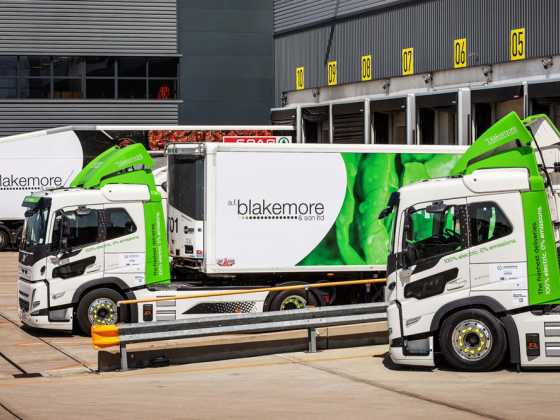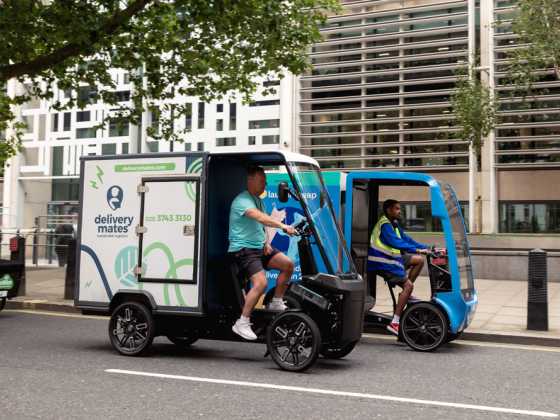Driving success at the GreenFleet Awards 2015
On 22 October, the green-minded fleet community gathered at Edgbaston cricket stadium in Birmingham to find out who would scoop a GreenFleet Award, the industry’s most coveted awards for environmental fleet management and low-carbon motoring.
 This year’s GreenFleet Awards once again shone a spotlight on the fleet operators, suppliers and manufacturers that are making great progress in minimising the environmental impacts of their fleets and vehicles.
This year’s GreenFleet Awards once again shone a spotlight on the fleet operators, suppliers and manufacturers that are making great progress in minimising the environmental impacts of their fleets and vehicles.
Richard Lowden, founder of Green Motion, the 2015 Awards sponsor, said: “I was delighted that Green Motion car rental had the opportunity to be the Headline Sponsor for the 2015 GreenFleet Awards. This was a very special year for Green Motion with us celebrating our eigth year and opening in our 20th country, and as such we are very proud to be associated with the GreenFleet Awards, due to their tremendous efforts being ambassadors for green motoring both here in the United Kingdom and throughout Europe.”
All new cars and small vans produced from September are required to be Euro 6 compliant, and from September 2016, this will apply to larger vans as well. Failing to adhere to these new regulations and reach air pollution targets could see fleets receiving potential fines.
This being said, the need to curb vehicle emissions is becoming ever more pressing. Year-on-year, organisations who operate fleets, as well as the motoring industry and fleet suppliers, are putting increasing effort into reducing the impact of their transport operations and vehicle production. The 2015 GreenFleet Awards championed these efforts, celebrating environmental fleet management and green motoring, awarding dedicated companies and individuals who are passionate about promoting a cleaner environment.
About our host
This year’s Awards was hosted by British actress, writer and comedian Jo Caulfield. In 2010, Caulfield was nominated as ‘Funniest Woman 2010’ at the LAFTA Awards, having previously been nominated as ‘Best Female Comedian 2002’ and ‘Best Compere 2004’, both at the Chortle Awards. She was also named as one of ‘The 100 Greatest Stand-Ups’ by Channel 4.
She has appeared at major comedy clubs, both in the UK and overseas, and has completed two solo nationwide tours, and a further three as support act of Graham Norton and Rory Bremner. For the last nine years, Caulfield has taken a new solo comedy show to the Edinburgh Fringe. Caulfield was comedy writer and programme consultant for all five series of the BAFTA Award-winning So Graham Norton.
Caulfield’s own TV appearances include: Never Mind The Buzzcocks; Mock the Week; The Stand-up Show; The Comedy Store; The World Stands Up; Have I Got News For You; Argumental; and The Politics Show. Most recently, she appeared on ‘Michael McIntyre’s Comedy Roadshow’. All of her comic history allowed Jo to quickly whip the room into a frenzy of laughs, which allowed for a smooth transition into the climax of the evening – presenting the all important awards. E
Fleet Manufacturer of the Year
This year, BMW has regained the title of Fleet Car Manufacturer of the Year, a category sponsored by Rockingham. The BMW Group is redefining personal mobility with revolutionary, purpose-built vehicles that embody sustainability, which is allowing for a substantial reduction in environmental impacts across the entire value chain.
Through ConnectedDrive and EfficientDynamics technologies, the BMW Group is successfully reducing emissions while increasing driving pleasure across its whole product range, with new models including the BMW 1 Series, BMW 3 Series, BMW 7 Series, Mini Clubman and the decision to enter the PHEV market with the X5 PHEV, 225xe Active Tourer PHEV, 330e PHEV and 7 Series PHEV models announced for 2016.
Earlier this year the arrival of the new BMW 1 Series brought with it the BMW 116d ED Plus Hatch which produces CO2 emissions of just 89g/km and has a BIK of 16 per cent. The BMW Group also launched the new BMW 3 Series in September which included the BMW 320d ED Plus Saloon model suited towards the corporate audience.
The new ED Plus model can achieve an impressive 74.3mpg (combined) with CO2 emissions at just 99g/km meaning a low BIK rate of just 17 per cent. November 2015 sees the launch of the new BMW X5 xDrive40e. Equipped with eDrive hybrid technology, CO2 output is just 77g/km, resulting in a BIK of 13 per cent. The Group also announced that Business Navigation will be standard across all models by September 2015. Combined with some of the other standard features such as BMW Emergency Call, DAB radio and Bluetooth with audio streaming, every BMW offers an extensive suite of advanced communication and entertainment features.
The BMW Group Five Star Rating programme, introduced in the past year, has also contributed to improving the BMW Group’s offering to fleet and business customers. The programme allows customers to rate their retailer experience out of five and leave feedback, which is then published on the individual retailer’s websites. BMW and Mini retailers play a significant part in the relationship with fleet and business customers. The five star rating system is invaluable to customers as it gives a clear and accurate indication of the service they will receive.
The king of small cars
Citroën celebrated success in the City Car Manufacturer of the Year, sponsored by Green Motion. Citroën has a range of 61 cars that are sub-100g/km, and today there are now more Citroën/DS ultra-low emissions city cars available than ever before. The company’s range includes the newly repositioned C-Zero full-electric city car, which is now available on-the-road, with the government plug-in grant, for just £11,995. In addition, it now includes a continually expanding range of efficient three-cylinder petrol engines, with the award-winning PureTech range now available in power ratings of up to 130bhp.
There is a huge choice of sub 120g/km CO2 emissions, Citroën/DS city cars powered by the expanding range of BlueHDi diesel, and diesel micro-hybrid driveline, as well as the unique diesel and diesel/electric hybrid DS5 Hybrid4. All BlueHDi engines can run on up to 30 per cent biodiesel for further emissions reduction benefits, without modification or effect on warranty. As part of Citroën/DS’s growing ultra-low emissions range is the C1, which now includes no less than 22 sub‑100g/km models. The C1 offers a choice of 68hp and PureTech 82hp three-cylinder petrol engines, three/five-door versions, Airscape three/five door folding roof models, five-speed manual or ETG automated manual gearboxes and three trim levels. Petrol-engined C1 CO2 emissions range from 88g/km, with combined cycle economy of up to 74.3mpg, low insurance groupings from just 6E and 13/14 per cent BIK.
The ultra-low-emission C4 Cactus reflects the company’s philosophy of reducing weight to improve efficiency. This mid-size five door hatchback uses the latest platform technology – and is up to 200kg lighter than other C‑Sector competitors. Its engine choice includes three-cylinder PureTech petrol engines, as well as Blue HDi diesel engines for emissions as low as 82g/km and exceptional combined cycle fuel economy of up to 91.1mpg. The spacious C4 Cactus range includes 10 models – all under
110g/km – with five at 100g/km or less.
In addition to the C-Zero, C1 and C4 Cactus, Citroën/DS now offers an extensive range of sub-100g/km superminis, coupes/cabrios, lower medium hatchbacks, full-size five and seven-seat people carriers and DS5 diesel/electric hybrid premium hatchback. The complete sub‑120g/km Citroën/DS range now includes no less than 151 cars, with the choice of all the available styles offered in sub‑100g/km format plus upper medium saloon/estate, lower medium people carriers, as well as mid-size crossover coupes.
Plug-in hybrid EVs
Last year, GreenFleet added a new category to its awards, to cater for the changes in low‑emission technology. This new category is for the manufacturer of the best plug-in hybrid electric vehicle (PHEV). This year Mitsubishi won the award for its Outlander PHEV, which is the world’s first plug-in hybrid 4x4 SUV.
Historically, 4x4 vehicles have had the reputation of being gas-guzzlers. But Mitsubishi’s plug-in hybrid electric version of its Outlander is a remarkably clean car. It can do 32.5 miles in pure electric mode and it also has a 2.0 litre petrol engine, giving the car a claimed 512 miles. The theory is that, for most people’s daily commutes, which average 25 miles (according to data released by the Society of Motor Manufacturers and Traders), the electric power will be sufficient and you won’t need to fill up at the pumps. But for long distance trips, the petrol engine will get you there. The quoted fuel economy figure is a staggering 148mpg. What is interesting is that you can also charge the car up using the petrol engine, which powers a generator, if you needed electric power and couldn’t get to an external source.
Another clever feature is that you can save the power on the battery if, for example, you had a stretch of motorway to do before reaching a town. Generally for hybrid technology, you have to pay a premium over the diesel/petrol option. But the Outlander PHEV is the same price as the diesel version – £28,249 after the government grant. What’s more, there are no compromises due to the size of the battery, in that you still get five seats and have the same boot space, something that other hybrids can’t always claim.
Double success in electric & LCVs
Nissan celebrated double success this year, taking home the LCV Manufacturer of the Year Award and Electric Vehicle Manufacturer of the Year Award, sponsored by EDF Energy.
Nissan is the true pioneer of the booming electric vehicle market having launched the first generation Nissan Leaf – the first mass market pure EV – back in 2011. More recently, while most other manufacturers were taking their first tentative steps into EV, Nissan launched a second generation Leaf, the multi award-winning e-NV200 panel van and the e-NV200 Combi (available with five or seven seats) and the luxurious e-NV200 Evalia. Nissan has continued to change perceptions, debunk myths and eliminate the obstacles with EV technology.
After 35,000 European Leaf sales, Nissan was able to release figures that showed 99.99 per cent of its battery units remained entirely fit for purpose and the failure rate of its battery power unit is less than 0.01 per cent. After hearing about the performance of Nissan’s battery units, used car valuation experts, Glass’s, said they would likely be revising their Leaf residual value estimates upwards. All this, of course, was of particular interest to fleet operators, keen to understand every aspect of a vehicle’s performance before taking the plunge. All-in-all then, Nissan is continuing to do more than any other manufacturer to increase the take-up of EV technology.
Nissan also came out on top in the LCV Manufacturer of the Year. Nissan is already on its second generation of light commercial vehicle and the brand has taken the proven technology that’s powered its record breaking British-built Leaf to phenomenal sales success across the globe and used it to revolutionise the LCV market. Based on the NV200, the e-NV200 does everything you’d expect from a modern van, but with zero emissions and low running and whole life costs that will make it a sure-fire winner with fleet operators.
However, it’s the impact this vehicle could have on fleets up and down the country that makes Nissan deserving of the GreenFleet LCV Manufacturer of the Year title. For the first time, LCV operators have a credible option that can stand-up to the day-to-day demands placed upon a working van while delivering on an unemotional financial footing as well as on an environmental level.
The e-NV200 has a practical 106-mile range, more than enough to accommodate the daily distance clocked up by most of the UK’s vans – 35 per cent of which never cover more than 80 miles a day. What’s more, a rapid charger can charge the batteries to 80 per cent full in as little as 30 minutes. Maintaining a cost of 40 per cent less than a conventional van as it has no engine oil, fewer filters and no belts or clutch to replace or inspect.
But none of this comes at the cost of the e-NV200’s performance as a hardworking van. It offers an impressive 703kg payload capacity and can comfortably accommodate two Euro pallets. The e-NV200 has very low running costs, from as little as two pence per mile, exemption from VED and a starting price of just £13,568 (including the government’s PiVG). Nissan estimates that e-NV200 drivers can expect to benefit from up to £2,500 of fuel savings, while maintenance costs will be reduced by £575 based on servicing, parts and wear and tear. Those figures are enough to make LCV fleet operators consider electric for the first time.
LGV Manufacturer of the Year
DAF Trucks scooped this year’s LGV Manufacturer of the Year Award. DAF Trucks has improved on an array of areas including, extended Driver Performance Assistant Eco Mode, which is the new standard feature on all Euro-6 PACCAR MX-powered CF and XF models. This reduces engine torque in all but top gear, and Eco Mode saves fuel by reducing unnecessarily heavy acceleration. A touch of a button re-engages the engine’s full-torque when required. Another important product enhancement is the new Silent Mode available on CF and XF models powered by the Euro-6 PACCAR MX-11 engine.
Introduced principally for urban night‑time deliveries, Silent Mode is engaged by activation of a dash-mounted ‘Silent’ button. Beneath the cab, engine software alters performance characteristics to reduce noise levels to less than 72 dB(A). Predictive Cruise Control and Predictive Shifting, now available on Euro-6 CF and XF models, uses GPS technology to accurately pinpoint the truck’s location looking ahead to anticipate inclines and descents. With three pre‑programmed settings, the driver can choose the ideal balance of hill climbing speed and fuel economy; Predictive Cruise Control then adjusts the speed for the road ahead while Predictive Shifting selects the best gear. Both systems work in tandem to keep the truck in its highest gear for as long as possible while maintaining the ideal rpm range.
Thanks to its ability to ‘see’ the approaching crest of a hill, the system anticipates the descent and allows the road speed to fall. DAF’s Driver Performance Assistant (DPA) is standard across the DAF range. As a new feature on 2015 models, tachograph details can be viewed on the central information display, giving the driver a clear overview of driving and resting times to avoid infringements.
Innovation
TomTom Telematics won the Award for IT Innovation for the development of OptiDrive 360 which uses vehicle and map data to provide fleet drivers with predictive real-time driving advice, enabling them to anticipate the road ahead to reduce fuel consumption and improve road safety. The groundbreaking development advises drivers when to take their foot off the accelerator on the approach to junctions and roundabout, when to shift gear and what their optimum speed should be. OptiDrive 360 was launched in March 2015 following extensive research by the EU’s ecoDriver project of which TomTom Telematics is an active partner. The project targets a 20 per cent reduction in CO2 emissions and fuel consumption in road transport.
OptiDrive 360 scores drivers based on a total of eight performance indicators – speeding, driving events (such as harsh steering or braking), idling, fuel consumption, green speed, coasting (taking your foot off the accelerator while in gear), gear shifting and constant speed – which can be used as the basis for performance reviews, training and driver benchmarking. Although the product is new to market, gas distribution company SGN is already predicting savings in the region of £1million after introducing OptiDrive 360 across its 2,000-strong fleet. Having calculated that it was wasting 13,000 litres of fuel a month through vehicle idling alone, incidents of idling were cut by almost 68 per cent. Average fuel consumption meanwhile has improved by 11 per cent.
Investing in drivers
Energy Saving Trust (EST), Scotland was crowned champions in the Driver Training Initiative Award category. After EST Scotland implemented its FuelGood Driver Training it immediately delivered average fuel savings of 15 per cent and, based on the average annual mileage in Scotland (8,700 miles), annual savings of up to £235 are possible for each car driver. Other benefits of the training included reduced wear and tear on tyres, brakes and clutches, less accidents – anticipating the road ahead reduces the likelihood of accidents and reduced emissions, helping contribute to a cleaner, greener Scotland. In the financial year 2014-15, EST Scotland trained 3,295 drivers.
If each of these customers continued to use the tips they learned during training, it is estimated that they will collectively save 3,561 tonnes of CO2 in their lifetime. Over 300 companies in Scotland have organised FuelGood training for their employees, including FTSE 100 companies Carillion and Mitie as well as 28 Scottish local authorities, eight NHS Trusts, 16 universities and colleges – and STV Glasgow, which has trained over 10,000 individuals to date, since 2011.
Private Hire and Taxi Company of the Year
The award for Private Hire/Taxi Company of the Year, sponsored by Patons Group, went to London’s largest green private hire company, Addison Lee. With over 400 Toyota Prius hybrid and 400 Mercedes E Class hybrid (exec fleet) vehicles in circulation across the capital, Addison Lee uses cutting-edge technology to dispatch 4,500 drivers to more than 10 million passenger journeys per year. Operating in London for more than 40 years, Addison Lee is a major employer in London and the biggest private sector employer in the London Borough of Camden. Addison Lee is committed to working with the city authorities to effectively tackle emissions in the capital and contribute to a greener London.
Addison Lee has the largest fleet of environmentally friendly vehicles in London – and its cars are replaced every three years. The company’s trip allocation technology, designed and built in Britain, has reduced emissions by 33 per cent since 2000 by minimising the time vehicles spend not carrying passengers – so‑called ‘dead miles’. Moreover, in a further boost to its green credentials, the company has now set out a commitment to become the first PHEV provider to ‘geo ring-fence’ high pollution areas within the city. This means its smart allocation system requests that all hybrid drivers turn their vehicles to EV mode whilst driving through the four designated areas. This will reduce the amount of pollution generated in these areas by its vehicles.
Renting the green way
The award for Rental Company of the Year was presented to GreenMotion. Green Motion is an international car rental company which operates by offering customers low CO2 vehicles. Green Motion also abides by its all-embracing environmental policy, ensuring that its effect on the planet is minimal. Green Motion has gained success as a rental company that is genuinely committed to its environmental ethos as the lowering of CO2 emissions is not simply a project for Green Motion; rather, it is an intrinsic part of the company’s brand – it is in the company’s DNA.
Green Motion is a true ambassador for the green vehicle movement promoting, best practice and convincing its customers, companies and private individuals to make major behavioural changes when considering their vehicle rental purchases. The Green Motion model is unique as it does not charge a premium to go green, educating customers that they do not have to compromise on cost or comfort.
Green Motion has continued to ensure that it has the latest technology in low or zero emission cars and vans. The company’s fleet consists of electric, hybrid, particulate filtered diesel and low emission models. This year, Green Motion has increased the number of electric and hybrid vehicles in its fleet, with the Nissan Leaf being a particular favourite with its customers. The collective vehicle emissions remain market beating with the average sitting just over 100g/km (103g/km currently) which is over 30g/km lower than any of their competitors throughout the world.
Today, Green Motion is considered to be a top 10 global rental brand and has taken the green vehicle hire message overseas with the brand now operating in 22 countries/USA states (eight of which have been added in the last 12 months). Green Motion’s reach is continuing to grow throughout the world from the Middle East over to North America with the company being consider the true world ambassador for green car rental and of course now the largest green rental force.
Award-winning leasing company
Leasing Company of the Year, sponsored by Fiat Professional, was awarded to Automotive Leasing. Ten years on from their GreenPlan launch, having developed the project exponentially and expanding its reach to incorporate other public sector/not-for profit organisations, Automotive Leasing are proud to have seen an increase in alternative fuel volumes by 5750 per cent in a decade.
The GreenPlan project is a program that provides cost efficient ULEV solutions to the public sector and not for profit fleets – from replacing fleets with newer, cleaner substitutes such as hybrid, plug-in hybrid and pure-electric vehicles – to implementing technologies to reduce emissions by decreasing vehicle idling, monitor and manage driver behaviour and provide educational programmes on the benefits of ULEVs. Since their GreenPlan launch in 2005, Automotive Leasing’s average CO2 on its car fleet has tumbled to an average of 120g/km – a reduction of 28 per cent CO2 since the programme began – with 9.9 per cent of their total fleet less than 95g/km CO2. Furthermore, new car deliveries this year are on average 113g/km CO2.
A significant part of the project has centred on its proactive work to introduce ultra‑low emission vehicles (ULEV) in Scotland, which set itself the world’s most ambitious greenhouse gas reduction target: to cut CO2 emissions by 42 per cent by 2020. As well as extending the project scope to include 20 types of alternatively fuelled vehicles – from cars to electric sweepers across 98 public sector and /not-for-profit clients. Automotive Leasing has also partnered with the Energy Savings Trust for EV leasing and to promote its Environmental Driver Training Programme.
Automotive Leasing now serves 98 clients UK-wide who, together, have 585 alternatively‑fuelled vehicles on the UK road network. Additionally, five per cent of all Automotive Leasing vehicles on order are made up of electric vehicles and part hybrid electric vehicles. Further benefit is derived from the absence of particulate matter and other local emissions. Automotive Leasing has committed to carbon off-set emissions by planting forest, covering 22 acres and containing 10,800 trees in the Highlands of Scotland, balancing 900,000 tonnes of emissions from the fleet.
Private Sector Fleets and Fleet Manager of the Year
Gnewt Cargo scooped the award for Private Sector Fleet of the Year: Small to Medium. Gnewt Cargo is a FORS accredited, last mile logistics company operating in the Central London congestion charge zone using a fully electric fleet of over a 100 vehicles. Running an all EV fleet in a highly competitive logistic market with a focus on reducing pollution, particulate emissions and congestion.
In 2014 Gnewt Cargo took receipt of a further 55 electric Renault Kangoos ZEs to support its growing relationship with its anchor client, Hermes, as well as increasing volume through TNT and the DX. Renault believes that Gnewt Cargo has the largest commercial fully electric fleet in any city in the world and the largest commercial EV purchase they have ever had in the UK. In addition, Gnewt Cargo has also recently procured a further six Nissan e-NV200s.
Gnewt Cargo’s environmental impact is measured through independent assessment of its emissions (independently verified by the University of Westminster to cut CO2 emitted per parcel by 62 per cent on like for like deliveries). The company now delivers, on average, between 5,000 to 20,000 parcels daily into the Central London congestion charge, emission free, across all clients. Business is also expanding into other cities this year and next which will mean significant growth in fleet whilst maintaining a fully‑electric status. What’s more is Sam Clarke of Gnewt Cargo also picked up the Fleet Manager of the Year award. Sam has been instrumental in the implementation of the great work Gnewt has completed within the last 12 months and has led the way with electric and low-carbon motoring.
The Private Sector Fleet of the Year: Medium to Large, sponsored by Route Monkey, was awarded to Heathrow Airport who has been working with partners to reduce emissions from aircraft, vehicles and buildings to play its part in meeting EU and UK government air quality limits in the local area around Heathrow, while also reducing carbon emissions contributing to global climate change. Heathrow’s sustainability strategy, Responsible Heathrow, sets the airport’s ambitions to reduce environmental impacts, including reducing ground-based nitrogen oxides (NOx) emissions (aircraft, airside vehicles and airport related traffic) by five per cent by 2020 and reduce CO2 from Heathrow Airport Limited vehicles.
Heathrow Airport is reducing emissions from vehicles, and encouraging newer and lower emission vehicles in addition to progressing against its 2020 goal for every car or small van owned or on lease to be electric or a plug-in hybrid. Heathrow is leading the way for the airport community by cutting emissions from its own fleet of 450 vehicles and integrating electric vehicles into its operations. The airside ramp team now exclusively only drives zero-emission battery electric vehicles and it is projected that through leading the drive towards zero and ultra-low emission vehicles, annual emissions will be reduced from the airside fleet by approximately 100 tonnes of NOx by 2020.
A commitment of £5 million to investment in electric vehicle charging infrastructure to support the 400 companies at Heathrow to turn their vehicles and ground support equipment electric has been made and hundreds of electric charging points have been installed, including a specialised rapid charger for heavy airport ground support equipment and nearly all of its 830 baggage tugs are electric, making it one of the largest airside electric fleets in Europe.
Hydrogen vehicle technology development is also supported through hosting the UK’s first publicly accessible hydrogen fuelling station free of charge and participate in partnerships spreading the technology across the UK and European aviation industry. Through collaborative efforts, including the Heathrow Clean Vehicles Partnership which was established ten years ago, Heathrow has worked with airlines, manufacturers, and ground handling companies to reduce annual emissions of the airside vehicle fleet by approximately 3,000 tonnes of CO2 (nine per cent decrease) and 74 tonnes of NOx (28 per cent decrease) between 2008/9 and 2013.
Public sector fleets
The Public Sector Fleet Award in the small to medium category, which was sponsored by Automotive Leasing, was awarded to Oxford City Council. Following a major restructure at the Council, the overall direction of the transport team changed, which required significant changes to infrastructure and working practices with the aim to increase business and environmental efficiencies in the service and to become as self-sufficient as possible to counter local government cuts whilst improving their carbon footprint.
Oxford City Council achieved this through telematics and improved driver behaviour, specifically using technology and innovative driving aids, such as vehicle tracking, telematics and in cab electronic driver behaviour tools. The Council has been able to comprehensively target fuel, CO2 reduction and cost savings by identifying driver training needs and adapting driver behaviour and driving styles positively.
Oxford City Council is continually striving to reduce its carbon footprint and improve on emissions reduction through replacing vehicles with electric or other fuel-efficient technologies. It has also implemented a tyre management policy in partnership with the tyre distributor, Bandvulc, which ensures the efficient use of tyres. Oxford City Council has made considerable improvements within its fleet, including achieving a 70 per cent drop in environmental driving violations through the use of telematics, and a CO2/fuel saving of more than 10 per cent in its first year of use.
The Council’s CO2 reduction for the RCV fleet of 50 tonnes per year and its training has reduced the number of accidents in the last six months by 24 per cent and created better drivers, as well as saving in excess of 25 per cent wear and tyre replacement per year. With an overall saving of 3,500 miles per year for its fleet which translates to 6.7 tonnes CO2 reduction per year.
Elsewhere, the Public Sector Fleet of the Year: Medium to Large was awarded to Dundee City Council. A massive investment in electric vehicles is clearly paying dividends in terms of emissions and with an expected 600 users of EVs, a huge amount has been done to encourage both staff and the public to use EVs. Rev limiting, stop/start, vehicle downsizing and driver training are all helping to support fuel and CO2 reductions.
Public Sector Fleet Manager
This year Bob Murphy became the Public Sector Fleet Manager of the Year, which was sponsored by Alphabet. Bob is always looking to embrace the latest innovative technology as they strive to reduce carbon emissions. Within Edinburgh College, Bob operates a fleet of electric pool cars to provide staff with a sustainable, low-carbon transport options for intra-campus and other corporate travel. Thanks to this innovative and exciting project significant impacts have been made in reducing the number of trips once normally carried out in staff members’ own cars – the so called ‘Grey Fleet’ – with quantifiable and corresponding reductions in CO2 emissions and fuel expenses.
The cars have covered a distance of 100,000 miles to date and saved around 32 t/CO2e of GHG emissions which would have come from equivalent medium-sized petrol vehicles. Savings to the business so far are around £49,000, based on a fuel expenses claim rate of £0.45 per mile for the same mileage. A recent 1,000-mile round trip from Edinburgh to Somerset plus another from Edinburgh to Orkney have demonstrated that gaps in the charging infrastructure are closing, and that long distances can be travelled with confidence.
EV Champions
With so much good work going on by individuals championing the electric vehicle (EV) cause, this year’s GreenFleet Awards continued from last year’s inaugural category of EV Champion, and this year five winners were recognised. These were Mark Bonnor‑Morris from Siemens, Bianca Alsop from Rolec Services, Mike Potter from Fleetdrive Electric, Clare Collings from Nissan and TV presenter and motoring journalist Quentin Willson.
Mark was recognised for helping position Siemens as the leading supplier of rapid chargers in the UK, Bianca for driving her team to becoming a leading supplier of recharging technology in the UK, Mike for incorporating over 300 EVs within their fleet, Clare for being such a prominent force when it comes to selling EVs within the UK, and last but not least, Quentin Willson was awarded for his ongoing contribution to creating better motoring experiences specifically with EVs and encouraging the uptake of electric vehicles.
Industry Innovation
The GreenFleet Award for Industry Innovation this year went to Toyota for the Mirai. In Japanese, ‘mirai’ means ‘future’, and the Mirai is the future of motoring, as it runs solely on hydrogen. The Mirai is at the forefront of a new age of hydrogen fuel cell cars that allows you to enjoy long distance zero-emissions driving. As well as only producing water from its tailpipe – which means no impact on our planet when you’re driving - Mirai brings the unique Toyota Hybrid driving experience to a new level.
Hydrogen is pumped into the vehicle and the gas travels to a carbon-fibre reinforced fuel tank, where it is stored. Oxygen from the outside enters through the Mirai’s front air vent. Hydrogen and air travel separately to the fuel cell stack where electricity is generated through a chemical reaction. When you put your foot on the accelerator, the electricity powers the motor which is activated to move the Mirai. In the end, the only by-product of this process is water, which leaves through the tailpipe. The vehicles have already been snapped up, principally by business and corporate customers tempted by the model’s zero harmful tailpipe emissions. Karl Schlicht, executive vice president Toyota Motor Europe, said: “This marks the debut of a new age for clean mobility, a turning point in the history of the automobile. With Mirai and its fuel cell technology, Toyota is working on delivering clean, safe and enjoyable mobility. We are looking forward to the start of deliveries of the first Mirai to customers from September and to see the future taking shape on European roads.”
Outstanding Achievement
The final award of the evening was the Outstanding Achievement Award, sponsored by Green Motion, which this year recognises Mitsubishi who has furthered the progress of innovative green transport, through forward thinking and a long-term and successful commitment to the cause. Mitsubishi has contributed to what can only be described as a ‘revolution in the plug-in vehicle market’, particularly in the fleet sector. After recently passing its first birthday here in the UK market, it has overseen a meteoric rise to the top of the ‘Plug-In Food-chain’, surpassing all of its competitors. The Outlander PHEV has helped shape the future of Plug-In Vehicle adoption in the UK and fully deserved this year’s accolade.
Further Information
events.greenfleet.net/awards






